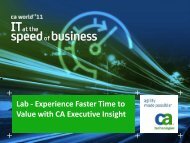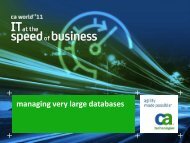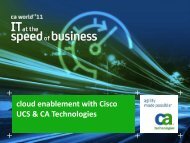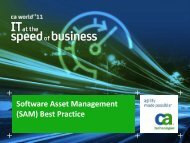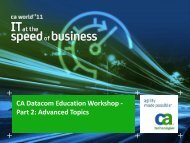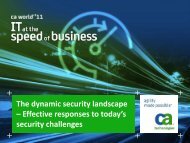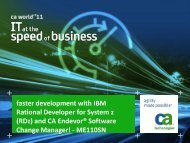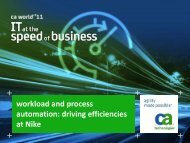Managing risk using the ITIL framework and CA service ...
Managing risk using the ITIL framework and CA service ...
Managing risk using the ITIL framework and CA service ...
- TAGS
- managing
- itil
- framework
- www.ca.com
You also want an ePaper? Increase the reach of your titles
YUMPU automatically turns print PDFs into web optimized ePapers that Google loves.
How a CMS is Delivering Sustainable<br />
Business Value Within a Leading<br />
Health Care Insurance Provider
Drive Business Value with Service & Portfolio Management<br />
PS112SN<br />
Boiling <strong>the</strong> Ocean, One Gallon at a<br />
Time – How a CMS is Delivering<br />
Sustainable Business Value Within a<br />
Leading Health Care Insurance<br />
Provider<br />
Doug Smith - HCSC Christian Iantoni - PwC
abstract<br />
Participants will learn how to identify incremental, measurable <strong>and</strong> sustainable<br />
business benefits through <strong>the</strong> implementation of a Configuration Management System<br />
(CMS). More specifically, we will discuss how Health Care Services Corporation<br />
(HCSC), as part of its ongoing IT Service Management transformation, is delivering<br />
value maturing its approach toward Service Asset <strong>and</strong> Configuration Management.<br />
Leveraging <strong>CA</strong> <strong>and</strong> o<strong>the</strong>r leading technologies in an integrated manner, HCSC’s IT<br />
organization is delivering business value, stakeholder by stakeholder, by foc<strong>using</strong> on<br />
what matters most – its customers. Whe<strong>the</strong>r supporting a data center build out to<br />
improve transaction processing, a Disaster Recovery <strong>and</strong> Business Continuity initiative<br />
to mitigate <strong>risk</strong>, or key ITSM processes to enable improved <strong>service</strong> quality, decrease<br />
operational costs <strong>and</strong> ensure regulatory compliance, HCSC’s CMS is proving value<br />
every step of <strong>the</strong> way.
iography<br />
– Doug Smith- Senior Manager, Health Care Service Corporation<br />
– Christian Iantoni – Director <strong>and</strong> National IT Service<br />
Management Practice Leader, PwC<br />
‐ Christian leads <strong>the</strong> PwC IT Service Management Practice nationally <strong>and</strong><br />
has been advising Fortune 500 companies on transforming <strong>the</strong>ir IT<br />
organizations to improve business performance for over 18 years.
agenda<br />
– The CMS Pursuit<br />
– Approach to Delivering Sustainable Value<br />
– Value Delivered<br />
– Lessons Learned<br />
– Q&A Session
The CMS Pursuit<br />
– As part of HCSC’s ongoing IT Transformation, IT Service<br />
Management has been a driving factor<br />
– Driving efficiencies to meet <strong>and</strong> exceed industry benchmarks for cost per member<br />
– Enabling an aggressive M&A strategy to provide higher quality <strong>service</strong>s to members<br />
– Ensure both IT scalability <strong>and</strong> agility through an ITSM maturity<br />
– Past CMDB initiatives provided initial value, but stalled<br />
– A bottoms up, “build it <strong>and</strong> <strong>the</strong>y will com” approach provided initial tactical value<br />
but stalled <strong>and</strong> was not embraced enterprise wide<br />
– Technology, while maturing, could not deliver on an integrated enterprise CMDB<br />
– The pursuit of <strong>the</strong> CMS <strong>and</strong> its associated value was too<br />
compelling not to re-invigorate <strong>the</strong> effort<br />
– Too much duplicate manual effort was being expended by both transformational<br />
<strong>and</strong> ongoing operational initiatives<br />
– Increasing availability, performance <strong>and</strong> <strong>service</strong> levels made a CMS m<strong>and</strong>atory
Approach to Delivering Sustainable Value<br />
- Where are we now?<br />
25+ “Trusted”<br />
Data Sources<br />
Manual CI<br />
Updates<br />
APM<br />
Team<br />
CM<br />
TEAM<br />
Inputs Interfaces<br />
Outputs<br />
ITG<br />
SME<br />
3<br />
Spreadsheets<br />
SMDB<br />
ITAM<br />
APM<br />
Auto<br />
Discovery Tool<br />
HP<br />
uCMDB<br />
CI Validation &<br />
Verification<br />
CM<br />
TEAM<br />
Current Gaps & Issues<br />
1. 25+ disparate, non-integrated data sources<br />
2. Custom built “Exchange” integration adaptor between HP uCMDB & <strong>CA</strong> CMDB<br />
3. CI’s not auto-discovered are input manually by <strong>the</strong> CM team<br />
4. CI validation & verification occurs in multiple locations<br />
5. Multiple views of configuration data<br />
6. Limited value for ITSM processes<br />
7. Minimal CI control<br />
1<br />
4<br />
2<br />
Exchange<br />
Adapter<br />
7<br />
Operational 5 Reporting<br />
Application maps are<br />
manually created <strong>and</strong><br />
maintained<br />
<strong>CA</strong> CMDB<br />
6<br />
CI Data Used<br />
CI Data Rarely Used<br />
CI Data Never Used<br />
Incident<br />
Management<br />
Problem<br />
Management<br />
Change<br />
Management<br />
Capacity<br />
Management<br />
IT Asset<br />
Management<br />
Disaster<br />
Recovery<br />
DC2 Migration<br />
Enterprise<br />
Monitoring
What is a CMS vs. CMDB?<br />
A CMDB is “database used to store Configuration Records<br />
throughout <strong>the</strong>ir Lifecycle”<br />
The Configuration Management System (CMS)<br />
“maintains one or more CMDBs, <strong>and</strong> each CMDB stores<br />
attributes of CIs, <strong>and</strong> relationships with o<strong>the</strong>r CIs.” *<br />
Integration Layer (Integrated CMDB)<br />
• This CMDB is a meta-database that serves to<br />
integrate data from all federated sources within <strong>the</strong><br />
CMS<br />
• Only those CI’s that will be managed under<br />
change control are represented.<br />
• HCSC: <strong>CA</strong> Service Desk currently supports<br />
this function<br />
Data Layer<br />
• Various repositories, including o<strong>the</strong>r CMDB’s,<br />
comprise <strong>the</strong> full scope of trusted sources for<br />
configuration item data in <strong>the</strong> enterprise<br />
• Only CI <strong>and</strong> CI attribute data that is managed<br />
under change control is federated to <strong>the</strong> integrated<br />
CMDB<br />
• HCSC: HP uCMDB will act as a federated data<br />
source that will supply auto-discovered CI’s<br />
<strong>and</strong> dynamic application mapping data to <strong>the</strong><br />
integrated CMDB.<br />
*<strong>ITIL</strong> v3 Service Lifecycle Publication<br />
Configuration Management System (CMS)<br />
Logical CI Record<br />
Only data that cannot be<br />
found in a federated source is<br />
stored <strong>and</strong> maintained in <strong>the</strong><br />
Integrated CMDB<br />
Integrated CMDB<br />
Data from trusted sources is retrieved dynamically by<br />
<strong>the</strong> Integrated CMDB only when requested <strong>the</strong>reby<br />
minimizing duplication of data<br />
Trusted Source Trusted Source<br />
Where <strong>the</strong>y are working, leverage<br />
automation <strong>and</strong> decentralized<br />
processes for CI maintenance<br />
As opposed to <strong>the</strong> monolithic CMDB, <strong>the</strong> CMS allows trusted sources to be federated over time, <strong>and</strong> as needed, to<br />
realize incremental value en route to a fully mature configuration management system.<br />
Trusted Source
Approach to Delivering Sustainable Value<br />
- Where are we going?<br />
HP<br />
uCMDB<br />
Inputs Interfaces<br />
Outputs<br />
Auto Discovery & Federated<br />
Data Sources<br />
APM<br />
1<br />
OVO<br />
CI Validation & Verification<br />
CM<br />
TEAM<br />
ITAM<br />
Future State Objectives<br />
1. Federation with trusted, authoritative sources of data<br />
2. Use of out of <strong>the</strong> box (OOB) wherever possible tool<br />
integrations to populate <strong>the</strong> CMDB<br />
3. Governance model established to ensure accurate<br />
management of CIs by CI owners (ITG SME’s)<br />
4. CI validation <strong>and</strong> verification occurs at CMDB<br />
5. Single view of configuration data<br />
6. CMDB has both dynamic <strong>and</strong> static CIs<br />
4<br />
2<br />
Reporting &<br />
Operational<br />
<strong>CA</strong> CMDB<br />
Application Mappings<br />
Automatically Maintained<br />
Controlled & Mapped CI’s<br />
Inventory Repository<br />
App<br />
3<br />
CI Management<br />
ITG<br />
SME<br />
5<br />
6<br />
Incident<br />
Management<br />
Problem<br />
Management<br />
Change<br />
Management<br />
Capacity<br />
Management<br />
IT Asset<br />
Management<br />
Disaster<br />
Recovery<br />
DC2 Migration<br />
Enterprise<br />
Monitoring<br />
Value<br />
-Improved MTTR<br />
-Reduced P1 incident volume<br />
-True impact of <strong>service</strong><br />
disruption<br />
-Improved trend analysis<br />
-Systematic removal of<br />
known errors<br />
-Single view of environment<br />
-Improved impact analysis<br />
-Business impact of change<br />
-Capacity planning<br />
-Automated provisioning<br />
-Historical utilization reports<br />
-Inventory discovery<br />
-Asset lifecycle management<br />
-Software management<br />
-Clear view of Prod vs. DR<br />
-Faster system recovery<br />
-Accurate view of<br />
environment <strong>and</strong> how it is<br />
configured<br />
-Faster requirements<br />
development for DC2<br />
-Enable proactive monitoring<br />
-Enhanced event correlation<br />
& analysis
Approach to Delivering Sustainable Value<br />
- Configuration Management Foundational Strategy<br />
• Improved customer<br />
satisfaction resulting from<br />
customer impact visibility at<br />
all levels within <strong>the</strong><br />
infrastructure<br />
• Improved <strong>service</strong><br />
availability due to real-time<br />
infrastructure visibility to <strong>the</strong><br />
entire commercial<br />
application portfolio<br />
• Improved <strong>service</strong> availability<br />
due to real-time visibility to<br />
mission critical application’s<br />
Infrastructure<br />
• Enhanced audit <strong>and</strong><br />
inventory control function due<br />
to exp<strong>and</strong>ed auto-discovery<br />
capabilities<br />
• Improved <strong>service</strong> availability<br />
due to static application<br />
mappings<br />
• Elimination of manual CI<br />
control processes<br />
Stakeholder Scope<br />
Business Management Groups<br />
• All enterprise applications mapped <strong>and</strong><br />
maintained automatically via CMS<br />
Service Management Groups<br />
• Mission critical top 20 SLA<br />
application mappings<br />
maintained automatically<br />
Infrastructure Management Groups<br />
• Enterprise application portfolio<br />
mapped <strong>and</strong> manually maintained<br />
• Auto-discovery capabilities extended<br />
to encompass <strong>the</strong> enterprise<br />
technology stack<br />
• HP uCMDB v9 upgrade completed<br />
• CMS enterprise governance<br />
model defined <strong>and</strong><br />
implemented<br />
Inventory Control<br />
• Departmental data repository<br />
migrations/federation completed or<br />
acceptance plan in place<br />
• Process gaps identified <strong>and</strong><br />
mitigated (ITSM, ITAM,<br />
Enterprise Monitoring, etc.)<br />
• Process Definitions / Roles /<br />
Responsibilities Updated<br />
• All LBOMs completed for DC2<br />
migration<br />
• Reporting strategy execution<br />
2011 (Q2-Q4) 2012 (Q1-Q2) 2012 (Q2-Q4)<br />
Service Management Operations<br />
• CMS/CMDB<br />
becomes <strong>the</strong><br />
authoritative<br />
source for<br />
DR planning<br />
<strong>and</strong> control<br />
End-to-End Service Manamement<br />
Functional Scope
Approach to Delivering Sustainable Value<br />
- Configuration Management Release Maturity Plan<br />
Consumers<br />
Data Owners<br />
1<br />
2<br />
October<br />
January<br />
April<br />
July<br />
2011<br />
2012<br />
2012<br />
2012<br />
Release 1 Release 2 Release 23 Release 24 Release 25<br />
<strong>CA</strong>SD Users – Manual Mapping of All DCII<br />
Applications 1<br />
DB2, WebSphere, SAN <strong>and</strong> AIX (P-Series)<br />
Frames - Enhanced Auto-Discovery<br />
capabilities 2<br />
Upgrade of HP UCMDB v8 to v9<br />
Re-platform of UCMDB into Prod 2.0<br />
Re-Implementation of Exchange to support UCMDB<br />
upgrade<br />
Implementation of Z/OS Auto-Discovery Tool to <strong>the</strong><br />
Mainframe Environment<br />
DCII Document Refresh<br />
Ability to see application to<br />
infrastructure mapping based on DCII<br />
LBOM <strong>and</strong> Visio documentation<br />
Establishment of baseline information<br />
needed in <strong>the</strong> CMS to appropriately<br />
map applications <strong>and</strong> maintain<br />
documentation<br />
1<br />
2<br />
3<br />
4<br />
5<br />
6<br />
7<br />
1 SLA Application - Alineo – Proof of Concept 1<br />
Migration of Valid DB to App Relationships<br />
from EDBA 2<br />
<strong>CA</strong>SD Users – CI Owner Contact Information 3<br />
<strong>CA</strong>SD Users – Manual Mapping of All DCII<br />
Applications Completed<br />
TLM - MS SQL Server – Technology Trend<br />
Report 4<br />
Application Owners – Alineo - Automated<br />
application infrastructure diagrams 5<br />
P-Series (AIX), EAS – Report 6<br />
DB2 Distributed – Report 6<br />
SAN Infrastructure – Report 6<br />
All – Config. Mgmt Critical Data<br />
Workbook (CMCD) 7<br />
AssetGen – Implementation, Configuration for Pilot –<br />
Alineo 5<br />
SMDB Feed to Exchange – Implementation– SMDB<br />
Migration Phase 1<br />
Exchange Feed to <strong>CA</strong> CMDB – Enhancements to Support<br />
Greater Attribute Synchronization<br />
UCMDB to BSM 9 Federation - POC<br />
Discovery Verification<br />
Application Mapping Workshop<br />
Knowledge-Release Management Integration for<br />
Executive Highlights<br />
Pilot ability to track CI relationships at<br />
<strong>the</strong> point of change <strong>and</strong> auto-populate<br />
application <strong>and</strong> infrastructure maps<br />
(currently <strong>the</strong>se are manually<br />
maintained)<br />
Fulfills Information Security database<br />
audit need<br />
Streamlines access to CI data for<br />
escalation, verification, <strong>and</strong> planning<br />
The ability to monitor <strong>and</strong> audit<br />
technology upgrades<br />
Pilot ability to view application<br />
infrastructure dependency data in an<br />
accessible, user friendly interface<br />
Provides auto-discovered data for<br />
validation & gap analysis/trending<br />
through scheduled reports<br />
Provide interim capability to view<br />
application mapped infrastructure from<br />
operational data stores<br />
Application Mapping<br />
~10 SLA Applications TBD – Phase 1<br />
Migration of Valid DB to App Relationships from<br />
DB2 Authoritative Source<br />
Stakeholder Deliverables<br />
Event <strong>and</strong> Problem Management – Autodiscovered<br />
Application <strong>and</strong> Infrastructure<br />
Relationships<br />
TLM - WAS – Technology Trend Report<br />
Application Owners – TBD - Automated<br />
application infrastructure diagrams<br />
All – Proportion of critical LBOM Fields<br />
migrated to <strong>the</strong> CMS<br />
WebSphere – WAS Map Report<br />
Technology<br />
AssetGen – Enhancements - ~10 SLA auto-mapped<br />
applications<br />
Migrate SMDB Reporting to Exchange – Implementation –<br />
SMDB Migration Phase 2<br />
Exchange Feed to <strong>CA</strong> CMDB – Enhancements to<br />
Support Aging<br />
Continued migration of additional data feeds from DRTA<br />
to CMS (SMDB)<br />
UCMDB to BSM 9 Federation - Implementation<br />
Integration of Z/OS data into <strong>the</strong> CMS<br />
Governance/Process<br />
Documentation Versioning<br />
AssetGen – Map Verification<br />
UCMDB – Map Verification<br />
Value Added for Stakeholders<br />
Remaining SLA Applications TBD – Phase 2<br />
Change Management –Auto-discovered<br />
Application <strong>and</strong> Infrastructure Relationships<br />
All – Remainder of critical LBOM Fields<br />
migrated to <strong>the</strong> CMS<br />
Migration of SMDB into <strong>the</strong> CMS – SMDB Phase 3<br />
Exchange – Enhancements to support <strong>the</strong> migration of<br />
SMDB<br />
Continued migration of data feeds from DRTA to CMS<br />
(WebSphere)<br />
CMS Guiding Principles:<br />
• Customer first<br />
• Incremental action rules<br />
• Market successes<br />
~20 DR Critical Applications – Phase 3<br />
Migration of EDBA into CMS<br />
Exchange – Enhancements to support EDBA migration<br />
Completion of data feed migration from DRTA to CMS<br />
with CMS assuming <strong>the</strong> majority of operational mapping
Value Delivered<br />
– Use Case #1 – New High Density Data Center Buildout<br />
– 170 Tier 1 application LBOMs developed to support migration to new data center<br />
– 2<br />
– Use Case #2 – Disaster Recovery & Business Continuity<br />
– CMS designed to include both static <strong>and</strong> dynamic CIs to drive adoption<br />
– Governing <strong>the</strong> TLM initiative focused on hardware <strong>and</strong> software enterprise<br />
st<strong>and</strong>ards (i.e. St<strong>and</strong>ard Reference Architecture)<br />
– Use Case #3 – Service Level <strong>and</strong> Problem Management<br />
– 170 Tier 1 applications auto-mapped for dynamic visualization <strong>and</strong> report delivery<br />
– CI governance model where authoritative data source owners manage changes<br />
– Integration with <strong>the</strong> Service Desk, Comm<strong>and</strong> Center <strong>and</strong> Change <strong>and</strong> Incident<br />
Management processes
Lessons learned<br />
– No tolerance for a big bang approach - implement Quick Wins that<br />
demonstrate measurable value to specific stakeholder/consumer<br />
groups within 3-6 months<br />
– Data governance, accountability <strong>and</strong> ease of updating are critical<br />
– Remember, information is your <strong>service</strong> <strong>and</strong> outputs your products<br />
– Automate only where it makes sense, don’t get mired in <strong>the</strong><br />
technical weeds <strong>and</strong> “draw <strong>the</strong> line” on CI discovery depth<br />
– Federate ra<strong>the</strong>r than consolidate wherever possible<br />
– Gain executive commitment to gain peer buy in<br />
– Don’t be shy – market your successes <strong>and</strong> build on <strong>the</strong>m<br />
– Communication, Communication, Communication<br />
13
Q&A
thank you<br />
Contact Information:<br />
Joe Nocera<br />
Email: joseph.nocera@us.pwc.com<br />
Office: (312) 298-2745<br />
Christian Iantoni<br />
Email: christian.iantoni@us.pwc.com<br />
Office: (312) 298-2913<br />
© 2010 PricewaterhouseCoopers LLP. All rights reserved. "PricewaterhouseCoopers" refers to<br />
PricewaterhouseCoopers LLP, a Delaware limited liability partnership, or, as <strong>the</strong> context requires,<br />
<strong>the</strong> PricewaterhouseCoopers global network or o<strong>the</strong>r member firms of <strong>the</strong> network, each of which<br />
is a separate <strong>and</strong> independent legal entity. This document is for general information purposes only,<br />
<strong>and</strong> should not be used as a substitute for consultation with professional advisors.
Related Technologies<br />
– Booth 448 – <strong>CA</strong> Service Desk Manager, <strong>CA</strong> Technologies<br />
– Booth 441 – <strong>CA</strong> Service Catalog, <strong>CA</strong> Technologies
Session # PS112SN<br />
Please scan this<br />
image to fill in<br />
your session<br />
survey on a<br />
mobile device
Terms of this presentation<br />
for information purposes only<br />
This presentation was based on current information <strong>and</strong> resource allocations as of November 2011 <strong>and</strong> is subject to change or<br />
withdrawal by <strong>CA</strong> at any time without notice. Notwithst<strong>and</strong>ing anything in this presentation to <strong>the</strong> contrary, this presentation shall<br />
not serve to (i) affect <strong>the</strong> rights <strong>and</strong>/or obligations of <strong>CA</strong> or its licensees under any existing or future written license agreement or<br />
<strong>service</strong>s agreement relating to any <strong>CA</strong> software product; or (ii) amend any product documentation or specifications for any <strong>CA</strong><br />
software product. The development, release <strong>and</strong> timing of any features or functionality described in this presentation remain at<br />
<strong>CA</strong>’s sole discretion. Notwithst<strong>and</strong>ing anything in this presentation to <strong>the</strong> contrary, upon <strong>the</strong> general availability of any future <strong>CA</strong><br />
product release referenced in this presentation, <strong>CA</strong> will make such release available (i) for sale to new licensees of such product;<br />
<strong>and</strong> (ii) to existing licensees of such product on a when <strong>and</strong> if-available basis as part of <strong>CA</strong> maintenance <strong>and</strong> support, <strong>and</strong> in <strong>the</strong><br />
form of a regularly scheduled major product release. Such releases may be made available to current licensees of such product<br />
who are current subscribers to <strong>CA</strong> maintenance <strong>and</strong> support on a when <strong>and</strong> if-available basis. In <strong>the</strong> event of a conflict between<br />
<strong>the</strong> terms of this paragraph <strong>and</strong> any o<strong>the</strong>r information contained in this presentation, <strong>the</strong> terms of this paragraph shall govern.<br />
Certain information in this presentation may outline <strong>CA</strong>’s general product direction. All information in this presentation is for your<br />
informational purposes only <strong>and</strong> may not be incorporated into any contract. <strong>CA</strong> assumes no responsibility for <strong>the</strong> accuracy or<br />
completeness of <strong>the</strong> information. To <strong>the</strong> extent permitted by applicable law, <strong>CA</strong> provides this presentation “as is” without<br />
warranty of any kind, including without limitation, any implied warranties or merchantability, fitness for a particular purpose, or<br />
non-infringement. In no event will <strong>CA</strong> be liable for any loss or damage, direct or indirect, from <strong>the</strong> use of this document, including,<br />
without limitation, lost profits, lost investment, business interruption, goodwill, or lost data, even if <strong>CA</strong> is expressly advised in<br />
advance of <strong>the</strong> possibility of such damages. <strong>CA</strong> confidential <strong>and</strong> proprietary. No unauthorized copying or distribution permitted.



